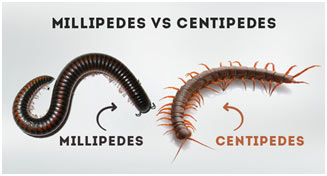Centipedes VS Millipedes
Both centipedes and millipedes have segmented bodies and belong to the group Myriapoda. Both breath through spiracles and have no direct copulatory organs. However, numerous differences exist between centipedes and millipedes.
Most people have problems telling us that these are two different organisms. So here we provide you with the easy answer to this question.
Differences between Centipede and Millipede
| Characteristics | Centipede | Millipede |
| Class | Belongs to class chilopods. | Comes from class diplopods. |
| Number of Species | Almost about 8,000 species. | Almost about 12,000 species. |
| Habitat | Occur in all environments and are prominent in deserts and arid environments. | Take place mainly in wet deciduous forests since a lot of species lack a waxy cuticle as a desiccation barrier; some types occur at high elevations in “alpine” environments and a couple of them prosper in deserts. |
| Spiracles | Spiracles located laterally; in some kinds, they are valvular and can be closed. | Spiracles situated ventrally; they are never valvular and cannot be closed. |
| Antennae | They have long antennae. | They have short antennae. |
| Number of legs | They have one pair of legs per body segment. | They have two pairs per body segment, except for the very first 3 segments, which have one set each. |
| Appearance of legs | Visibly extend from sides of the body; path backward behind the body. | Do not visibly extend from the body; rear leg sets in line with the body. |
| Feeding habits | They are carnivorous and predators. | They are scavengers. |
| Movement | They are quick moving or fast runners. | These are slow walkers. |
| Bite | They can bite. | They do not bite. |
| Venomous | They are venomous. | They do not have venom. |
| Defensive mechanism | Use their quick transfer to escape predators, injects venom to immobilize victim, and can squeeze prey with back legs. | Curls body into tight spirals to protect their soft undersides, head, and legs. They can burrow quickly. Lots of species discharge a stinky and disgusting-tasting liquid that repels many predators. |
 |
 |

